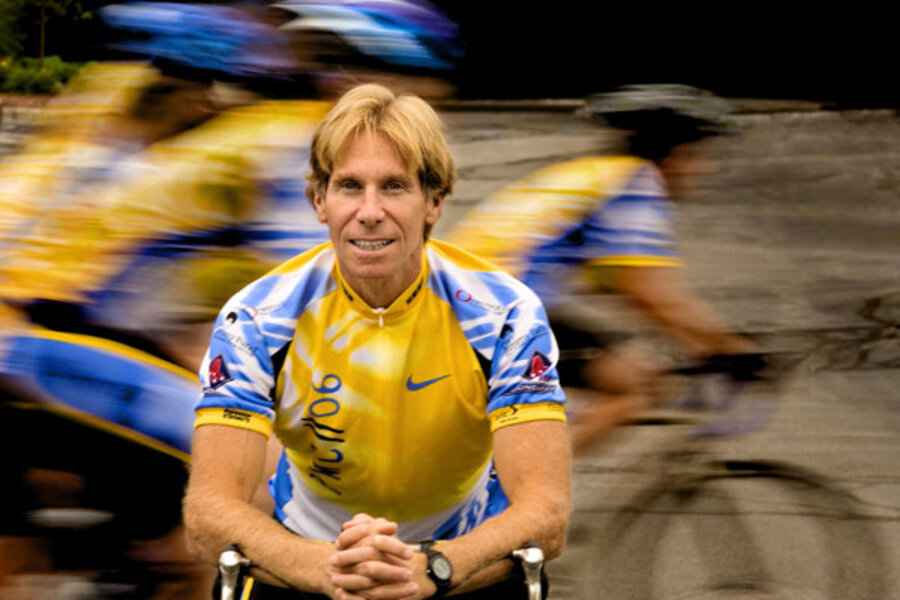Pan-Mass Challenge: How cyclists raise the most money for charity
Loading...
| Needham, Mass.
On Aug. 6 and 7, more than 5,000 cyclists will ride on 11 routes throughout Massachusetts for the 32nd annual Pan-Mass Challenge (PMC). Routes range from 25 to 190 miles, and take one to two days to complete. To date, the event has raised $303 million, all for The Dana-Farber Cancer Institute through its Jimmy Fund. The PMC, which is responsible for more than 60 percent of the Jimmy Fund’s annual revenue, was one of the first athletic fundraising events in the country, and raises more money each year than any other single athletic fundraising event, say organizers. We sat down with the PMC’s founder and executive director Billy Starr to ask, how can one event raise so much money for charity, again and again?
The Monitor: How much money does the PMC raise each year?
Billy Starr: This will be our fifth year of $30 million-plus dollars. We’ve raised over $166 million in five years.
Q. What is the minimum amount of money that a participant has to raise?
A. It’s $4,200 [for the longest route] to Provincetown, where 70 percent of all riders ride. All the routes have different minimums, from $500 to $4,200.
Q. What advice do you give to people about fundraising?
A. Particularly in the early months, we say engage, engage early. Some are nervous about the physical aspects, some are nervous about the fundraising. But when they come back year after year, most of them would say typically that the fundraising is more of a burden that the riding, until they hit about age 50!
Don’t register if you’re not serious about fundraising. The bike event is our thank you to you for fundraising. When you’re orchestrating 5,000 people like we are, sheer data says you’re going to lose 2 or 3 percent of them to injury, wedding, or pregnancy. But just because you broke your leg, it doesn’t mean you feel any different about funding cancer research.
Q. How has the PMC served as a model for other organizations?
A. When I started, event programming was considered the poor step-sister to the black tie fundraiser, the rich person, and the idea of creating events to raise money. Nobody saw this demographic as being this dynamic. We started pretty blue collar in the 80s, but it evolved, like the sport of biking evolved.
This was the first event in the country to put up a credit card rule, that was 15 or 18 years ago, and virtually every other event has followed suit. Before we allow you to register, you have to sign three times that you understand the following comment: You owe the money. You cancel tomorrow, you owe the money.
"[For instance] if you have [pledged] a $4,000 minimum, and you only raise $2,000, we’re billing you 2,000 bucks" [on your credit card].
In the earlier years, we had minimums, but people often fell short and said, “Well I did the best I could.” I said, “That’s unacceptable.” The credit card changed all that.
Q. What kind of safety issues come up with an event of this size?
A. On a typical PMC, the biggest issue is dehydration. We have separated shoulders, clavicles, and road rash every year. We have had two fatalities in 32 years of it. It’s hard. Anyone involved in any kind of event programming lives with that possibility and does everything they can to prevent it.
Q. You say that, on average, individual participants in biking events raise more money than participants of other kinds of athletic fundraisers. Why is biking so successful?
A. It’s a real event. Walking is definitely not an event. Biking involves speed, teamwork, travel, and some element of danger. It’s a bigger experience than running or walking, in my opinion.
Q. Do you bike the PMC every year?
A. I’ve biked it all 32 years. I’ve raised about $1.2 million. That was also part of the model. I would never ask anyone else to do what I wouldn’t do myself.
Q. The PMC raises about three times as much as any other single athletic fundraising event in the country. Why can’t anyone else come close to touching the PMC’s success?
A. We’re aggressive. I’m aggressive. I built a brand that required you to make a commitment. I think that’s not for everyone.
Q. What’s the biggest criticism of the event?
A. That it’s too expensive. But we never pretended to be for everybody. No event can be all things to all people, and it’s disingenuous to suggest otherwise. We need to raise money for cancer research. Nobody from this demographic needs to be further educated about cancer awareness. It’s an educated group. This group wants to forever change the landscape of how life is fully lived, with or without cancer.





